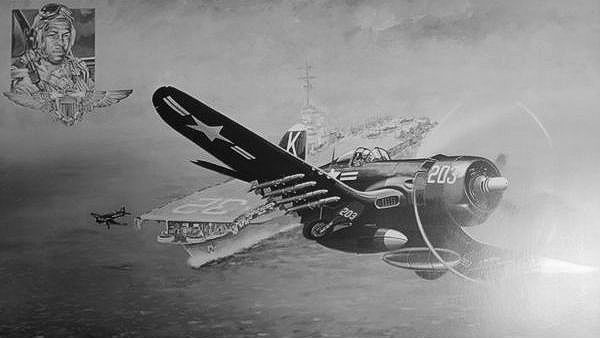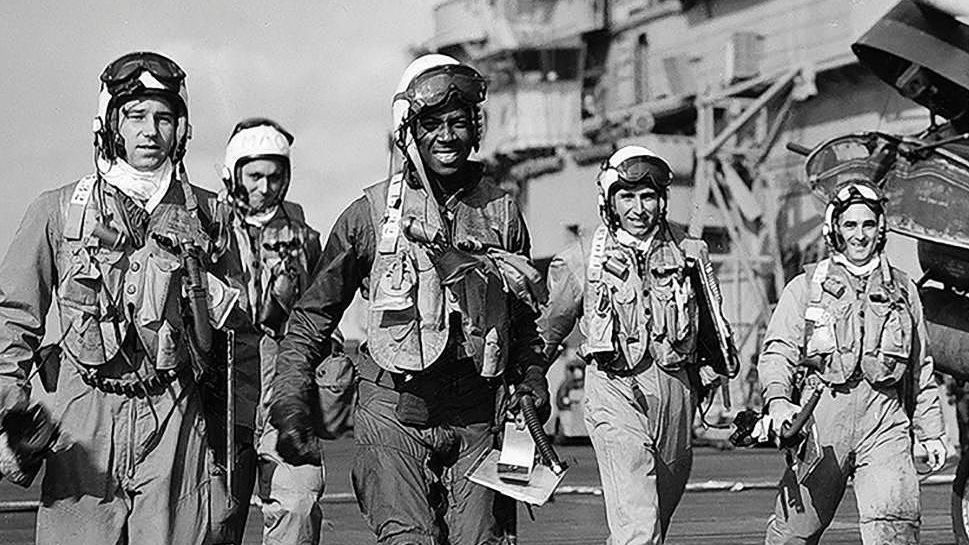5/30/2023
BREAKING THE RACE BARRIER: HOW Jesse Brown BECAME THE navy'S FIRST BLACK AVIATOR
Many of you may be familiar with Devotion, the 2022 film based on Adam Makos’ book Devotion: An Epic Story of Heroism, Friendship, and Sacrifice. The movie follows the inspirational true story of Jesse Brown (played by Jonathan Majors), the first Black aviator in the history of the United States Navy. Along with his wingman Tom Hudner (played by Glen Powell, who also portrayed naval aviator Jake “Hangman” Seresin in Top Gun: Maverick), the pair, through their heroic sacrifices, helped turn the tide in the Battle of the Chosin Reservoir—one of the most brutal battles in the Korean War. However, did you know that Jesse Brown completed his Selective Flight Training right here in Glenview, Illinois?
A Mississippi native, Brown attended his first airshow at age six with his father—an experience he later cited as one of the first that sparked his interest in aviation. When planes flew overhead as he worked in the corn and cotton fields, Brown declared that he wanted to be a pilot. His family would simply respond with a considerate laugh, merely taking the comment as a joke like many others would on Brown’s journey.
Brown’s superb high school performance in math and sports, including football, basketball, and track and field, earned him admission into Ohio State University, which, in 1944, was still a predominantly white institution. An architectural engineering student, Brown was the only black student in OSU’s College of Engineering and maintained stellar grades despite working two part-time jobs to help pay for his tuition.
It was during his sophomore year when Brown stumbled upon a poster for the Navy’s V-5 Aviation Cadet training program. When he hurried to the recruitment office to sign up, however, the recruiter declared that Brown wouldn’t be able to pass the written exam portion and maintained that even if he miraculously did, he could never fly a Navy plane because there had never been a black aviator in the Navy’s history. Nevertheless, Brown’s determination and persistence convinced the officer to let him sit for the exam, and he passed five hours of written tests, an oral test and vigorous physical exams with flying colors. Although Brown was accepted into the Navy flight training program, he remarked to a childhood friend in a letter that “I’m not sure the Navy really wants me.”
In July 1946, Brown joined OSU’s Naval Reserve Officer Training Corps (NROTC), which offered him a monthly stipend of $50 and allowed him to quit his part-time jobs and concentrate fully on school. After graduating OSU with honors in 1947, Brown received orders to complete his Selective Flight Training at Naval Air Station Glenview.
The program was the third of five required to become a qualified pilot and consisted of 11 to 14 weeks of training in an N3N biplane or an equivalent model after completing ground school, learning to fly smaller planes, and extensive physical fitness training. Despite Brown’s athletic talent, he was not a natural pilot. Like many of his fellow cadets, he had to put in extra effort to master the necessary skills, and some of his instructors at NASG were the ones constantly encouraging him to keep on trying.
After NASG, Brown completed additional training at Naval Air Station Ottumwa and Naval Air Station Pensacola and on October 21, 1948, became the first African American to complete Navy flight training at age 22. Now a section leader, Brown was assigned to fighter squadron VF-32 before transferring to the USS
Leyte to assist UN forces in Korea.
On December 4, 1950, Brown radioed to his wingman Lt. Thomas J Hudner Jr. that he lost his oil pressure on the way to Chosin Reservoir to provide air cover to a trapped Marine squadron before crash-landing the Corsair into the side of a mountain. Hudner, nervously circling the wreckage, quickly realized something was wrong when Brown didn’t emerge from the cockpit. Ignoring orders from his commanding officer and risking a court-martial, Hudner crash-landed next to Brown’s destroyed Corsair and found him in pain and trapped by a damaged instrument panel, rendering it impossible to rescue him. Brown, losing consciousness, asked Hudner to tell his wife, Daisy, how much he loved her before dying. As the possibility of capture by enemy forces grew imminent, Hudner was reluctantly forced to leave Brown behind.
Unable to safely recover his body, Brown’s squadron could only make low passes over his downed Corsair while reciting The Lord’s Prayer. Posthumously, Ensign Jesse Brown received the Distinguished Flying Cross, the Air Medal, and the Purple Heart and was honored with the launching of USS
Jesse L. Brown
in 1973.
To think that such a crucial milestone in American aviation history took his first steps on his journey right here in Glenview is quite fascinating and mind-blowing. Like many before him, Brown came to our town filled with hope and determination to break through barriers and become a trailblazer, and NASG gave him the tools to achieve that dream.
SOURCES
Patch, Nathanial. "Blue Star Turned to Gold: The Loss of Ens. Jesse L. Brown."
National Archives, Mar. 2023, rediscovering-black-history.blogs.archives.gov/2023/03/23/blue-star-turned-to-gold-the-loss-of-ens-jesse-l-brown/. Accessed 27 May 2023.
“Jesse L. Brown.”
Naval History and Heritage Command. Feb. 2023, www.history.navy.mil/content/history/nhhc/browse-by-topic/people/trailblazers/jesse-brown.html. Accessed 27 May 2023.
Paone, Thomas. "Jesse Leroy Brown: Ushering in a New Era of Naval Aviation."
National Air and Space Museum, Feb. 2023, airandspace.si.edu/stories/editorial/jesse-leroy-brown-new-era-naval-aviation. Accessed 27 May 2023.


